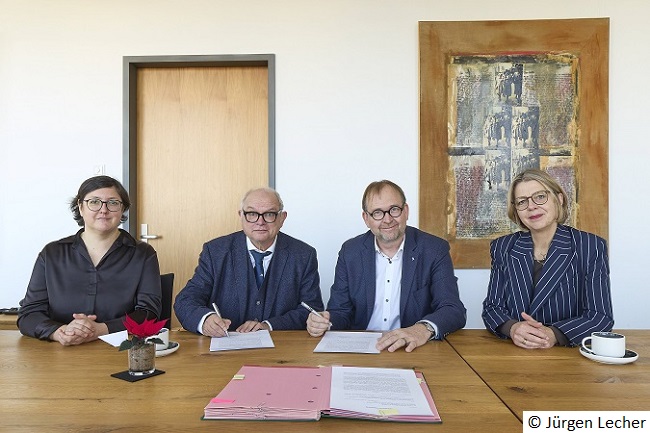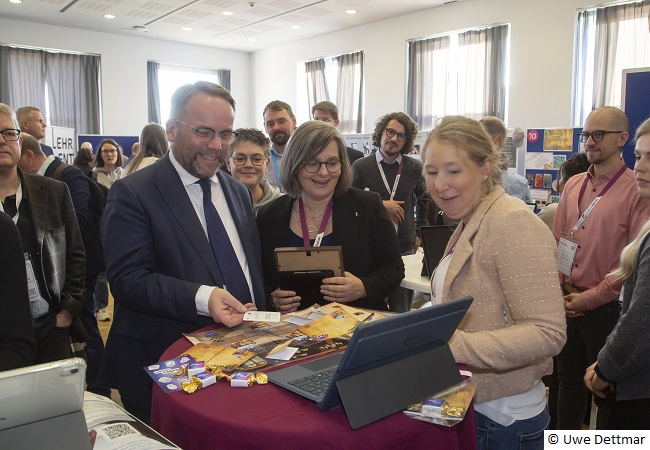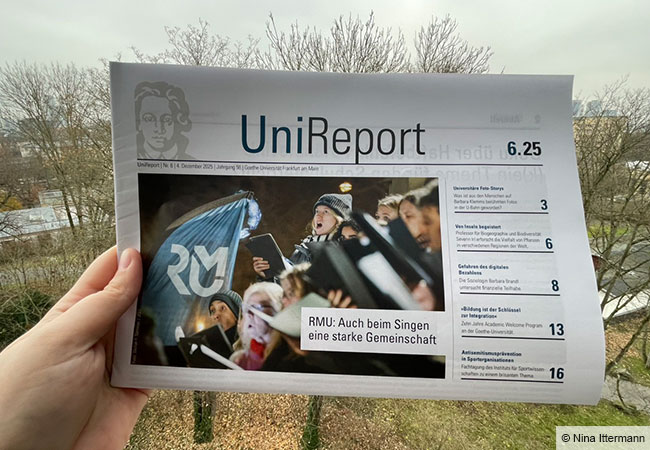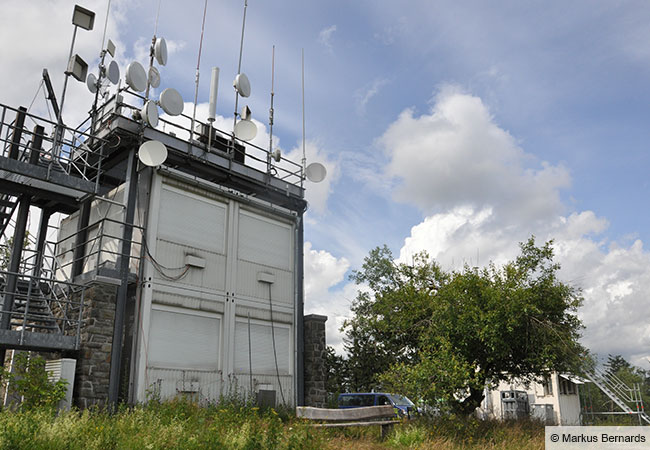Having been brought on board by fellow Goethe University scholar and archaeologist Professor Markus Scholz, Ancient History Professor Hartmut Leppin played a vital role in deciphering the “Frankfurt Silver Inscription”. Wrapped inside a silver amulet, the inscription was found in a grave dated to the 3rd century AD. The much-noticed find is the oldest material evidence to date testifying to the presence of Christians north of the Alps. Goethe University online spoke to Hartmut Leppin about the significance of the spectacular find.
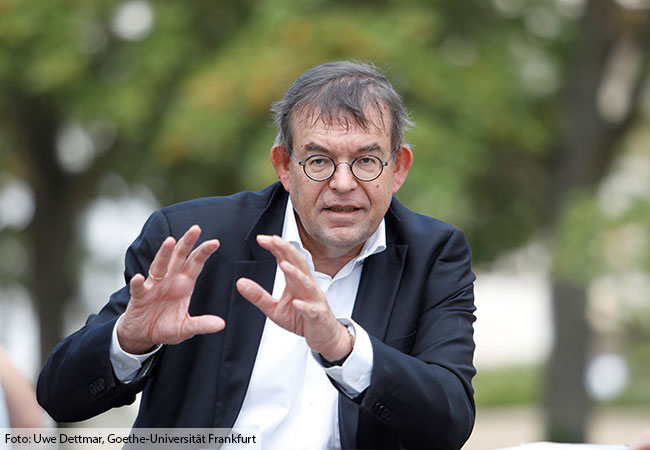
When did you learn about the find?
Markus Scholz informed me about it at the end of the last summer semester. We then looked at the text together in his office. I’m no archaeologist; I specialize in the history of ancient Christianity. It is in this capacity that Markus Scholz consulted me, once he realized that he had an extremely unusual Christian text in front of him.
At that point he had already deciphered the distinct passages, especially the letter combination XP.
Yes, and the addition Hagios, Hagios, Hagios was also discernible. It was this context precisely that brought him to me.
Did he ask you to assist in deciphering or classifying the find?
Both. But my contribution to the decipherment was negligible. I was and am more concerned with the historical contexts.
Prof. Scholz says he was quite blown away by the find, whose implications were immediately clear to him.
To be honest, the first thing I asked myself was: Is this fake? The fact that a text with such content was found in this region at this time didn’t fit in at all with established thought. Incidentally, this is also the first question colleagues ask me when I tell them about the find.
And?
We can rule out the possibility of this being a forgery.
How can this be ruled out?
Firstly, as a result of the find’s history. Added to that: No intelligent forger would forge something that so obviously just doesn’t fit. And a clueless forger is out of the question: it takes real expertise to fake this kind of writing.
When did you realize the significance of the find?
Even with the points mentioned above, it was immediately clear to me, as it would have been to anyone with any expertise in this field. Nevertheless, I first had to rule out everything that spoke against it being the earliest evidence of Christianity north of the Alps. It took me a while to truly accept that.
What could have been other possibilities?
The amulet could have been wrongly dated. A Roman living at a later age, who visited the area, could have dropped it. Once I had ruled all that out, I looked for clues to confirm the previous assumptions.
And where did you find these?
With a certain Irenaeus of Lyon, a 2nd century author, whose writings contain a passage indicating that there were Christians living in Germania. We did not take this very seriously up to now, although there was of course no way to rule it out either, even before the Frankfurt find. What we have here now is a Christian from this region – and it appeared increasingly likely to me that this was not someone who had simply traveled through.
What led you to conclude that?
Christianity usually followed in the footsteps of traders. First evidence can be found in port cities – like Corinth and Ephesus, for example – with other areas following later. It would not be so surprising if a Christian from Lugdunum (Lyon) or Rome had come to the area and stayed there for some time, especially given that Nida was quite prosperous. But this Christian was carefully buried here; his relatives deliberately placed the amulet with his remains so that it would not get lost. All of this strongly suggests that this was a person with local roots. Of course, it is also possible that the deceased was a second cousin or a merchant from somewhere or other who died in Nida while passing through and was buried by his acquaintances. But he must have had some connection to the town; such effort would otherwise not have been made. Incidentally, I wasn’t sure at first that we were dealing with a man. My guess was on a woman.
Why?
Because, as a whole, women converted to Christianity earlier. The religion offered them both opportunities for action as well as new roles. One key aspect was that they didn’t have to marry in order to lead a respectable life. The prevalent expectation at the time was that a woman should marry and bear children for her husband. Christian women, however, were able to justify remaining virgins – they even gained a certain social standing for this in their community, albeit often in conflict with their family. Beyond that, Christian women were able to afford to remain widows and did not have to enter into a new marriage. In fact, widows played a key role in Christian communities.
But you were wrong, the scientific analysis revealed that the deceased was a man.
Yes, and there was something else that surprised me: that the man communicated about his faith in Latin. I would have expected him to do so in Greek. Yet only the phrase Hagios, Hagios, Hagios is Greek, and even this in Latin script.
Your Leibniz project “Polyphony of Late Antique Christianity”, which you completed in 2023, was dedicated to researching the diversity of late antique Christianity, with a focus on the early 4th to the 9th century. Would the discovery have in any way changed your research?
It would not have changed the basic approach – which was based precisely on the premise that Christianity in antiquity was immensely diverse. This discovery would have constituted new evidence of this unexpected diversity. My research, however, focuses on the East, where Christian texts have also been handed down in non-classical languages, including Syriac/Aramaic and Coptic. What we have here is evidence of a Christian buried in the West, in a context where we so far have no knowledge about the prevalent structures of Christianity at the time. The find would certainly have enriched the project, and we would have been delighted to have such an early and informative Western source at our disposal.
What, from the perspective of the history of religion, is particularly remarkable about the find?
What we have here is a theologically-informed person, who knew a lot of passages from the Bible. Our theological advisors were particularly struck by the phrase Hagios, Hagios, Hagios, which comes from the Book of Isaiah and is used by Christians to refer to the Holy Trinity. All three – God the Father, God the Son and God the Holy Spirit – are holy. The fact that, in their understanding, this is already hinted at in the Old Testament, the Hebrew Bible, reinforced the belief of Christians living at the time that the Old Testament prepares the ground for the new one. In theological debates, however, this only started to play a role later on. Did this phrase have a very personal meaning for the deceased? Or did he associate it with theological debates? We simply don’t know.
Nor do we know whether the deceased wrote the inscription himself, whether he dictated it to someone or whether it was given to him by someone else, for example at his baptism, as is common practice today.
That is a very important point to make. If we were to put it with the utmost precision, what we can say with certainty is that a Christian discourse is reflected in the inscription inside this amulet, which those who buried this man left with this body. Theoretically speaking – although I personally find such a thesis a bit far-fetched – it could also be that the man was no Christian at all, but that his relatives wanted to see him as such. In today’s day and age, too, not every godchild is happy to receive a Christian hymnbook as a gift. Be that as it may, there is no way for us to rule out that the man was no Christian at all and that the amulet was merely given to him as a means of protection by someone who thought he could use it.
Maybe the man didn’t know the meaning of the inscription he was wearing even during his lifetime? After all, not everyone was able to read.
All these are possibilities. After the discovery, one article spoke of the first Christian being a Frankfurter. But it’s not that simple. While the probability that he was Christian is high, it is not entirely certain. Besides, Frankfurt didn’t even exist back then.
The exclusivity of the confession in the text is definitely unusual for the time.
Yes, something that is so self-evident today was rather unusual for that time. Back then, many perceived the Christian god as one powerful god alongside others. Those worshipping the Christian god could just as easily go to the temple of Jupiter or even the synagogue the next day. This remained the case until about the third or fourth century. What makes this find so spectacular and this amulet so unusual is that it is purely Christian: It only refers to the Christian god and it only uses words that can, with a very high probability, be attributed to Christianity. That is absolutely remarkable.
Christianity’s claim that there is only one God, similar to the cult of Akhenaten or Judaism, was not universally recognized at the time.
Not at all. At some shrines it was even possible to worship several deities at once – something that was quite normal in the ancient world. This meant one could address several gods, without denying the importance of any one of them. It is in this way that the Christian god was also “used” by some. There were, after all, many stories about his might and about the miracles he performs – so why not turn to him in need? Our research project has shown that such an unambiguous, exclusive form of Christianity was not a matter of course in the early days. It took a while for it to become established, although it should be noted that the Christians of the late antiquity were very much of the opinion that the ancient gods were alive, to the extent that they were demons.
This is something you have researched in the Mediterranean region, also because – until now – no sources from our region existed. The silver inscription is the first source from this period, so to speak.
Yes, it is a wonderful source with an incredibly wide reach. Fortunately, we already have very many and rich sources dating back to that time in the Mediterranean region: Numerous inscriptions – from the East especially – can be traced back to the second century AD. When Christianity was still forbidden, Christians declared their faith on their gravestones. We also have numerous literary texts written in Latin, from Rome and North Africa, which tell us a great deal about the everyday life of Christians. One of the authors is a certain Tertullian, who insists that Christians should only worship the Christian God: They should not go to the arena where other gods are worshipped, they should not take part in festivals for the emperor because at such occasions he is portrayed as godlike, they should not join the military because of the cults that exist there, etc. The premise on which such writings is based is that Christians usually must have behaved differently, which in turn illustrates just how unclear it was that the Christian god should be as exclusive as theologians would have liked. Even though it was already Paul who emphasized the exclusivity of the Christian God, there was and is no historical necessity for Paul to prevail.
Do you expect other sources of this kind to emerge?
I think it quite likely. Our technical capabilities have meanwhile become extremely good, and the sensitivity for such finds, which at first glance seem inconspicuous and which a layperson might simply throw away, has grown considerably. We probably won’t find a stone inscription. But something similarly small – why not? Nothing can be ruled out.
Has this region played a role in your research to date?
So far, the only manner in which I have touched on our region is in my teaching. But I wouldn’t rule it out: We always gravitate to the source.
What were the earliest sources of Christianity in our region?
Apart from the reference in Irenaeus, there are also references to bishops, some as early as the third century. However, as far as their definite attesting goes, this is only possible for finds dating back to the 4th century, i.e. the time of Constantine the Great and the supra-regional councils, whose participants we have lists of.
If a bishop existed, then the structures upholding this office also should already be in place.
Yes, there’s a high likelihood that some kind of Christian institution existed there, where people gathered for a service.
Do you think the man was a member of a Christian congregation?
He could also have been a Christian loner. As a Christian, he was not necessarily bound to any particular congregation. There also existed very individually-minded Christians, who had to be convinced to attend church with people of low standing. The fact that he was Christian does not mean church services were offered in this area during his time, although it does make it more likely that Christians also celebrated together here.
Do you often find yourself working together with archaeology?
Yes, we share many interests. Prof. Scholz and I, for instance, share an interest in inscriptions, mostly large stone inscriptions, as you can find them in museums. They have a context that requires understanding – something only archaeology can provide.
What can archaeology do that you can’t?
Based on the excavation, it can also determine an inscription’s context – information we often require in order to correctly interpret a text. With respect to visual finds, like drawings or images, too, archaeologists are able to delineate a wider context than many of us historians.
And are you engaged in an ongoing conversation or is the exchange limited to specific occasions? Is there a forum at Goethe University where you can exchange ideas on an interdisciplinary basis?
There is the interdisciplinary Colloquium Classicum at Goethe University, jointly organized by the departments of Ancient History, Classical Philology and Classical Archaeology. While the latter only recently joined the exchange, it has already proved to be extremely fruitful. Apart from that, there are many bilateral discussions and conferences, and also the occasional jointly-supervised qualification theses. Of course, a lot of this exchange concerns a specific event or occasion, but I naturally also consult the specialist archaeological literature; I want to know what is being found. It is, after all, archaeologists who “produce” most of the new sources.
You plan to continue researching the silver inscription. What might that look like?
One thing I could imagine is pursuing the topic of Hagios, Hagios, Hagios. Another alternative would be to systematically compare the amulet’s verses with those found in other amulets. It would certainly make for an interesting master’s thesis, for example, to take a closer look at Greek amulets to determine what if any points of comparison exist.


